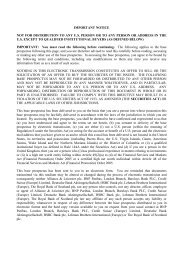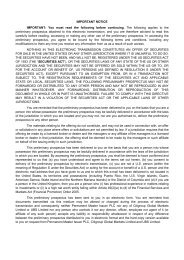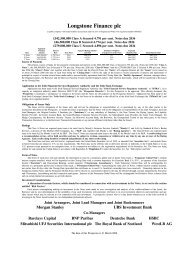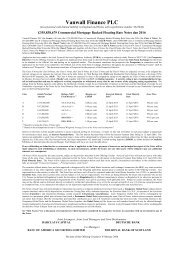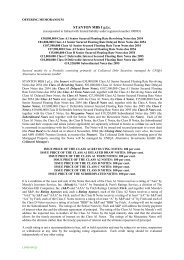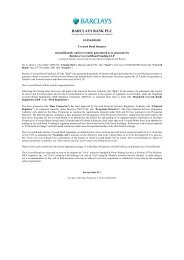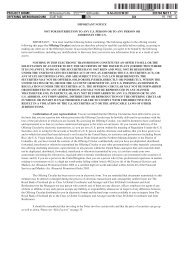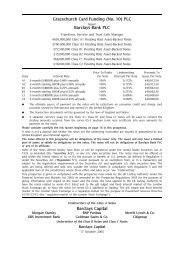Offering Circular. - SFM
Offering Circular. - SFM
Offering Circular. - SFM
Create successful ePaper yourself
Turn your PDF publications into a flip-book with our unique Google optimized e-Paper software.
Portfolio. In each case the performance by the Issuer of its obligations under the Transaction Documents is<br />
also dependent on the solvency of, inter alia, the Servicer.<br />
In the event of the termination of the appointment of the Servicer under the Servicing Agreement, it would<br />
be necessary for the Issuer to appoint a substitute servicer (acceptable to the Representative of the<br />
Noteholders). Such substitute servicer would be required to assume responsibility for the provisions of the<br />
services required to be performed under the Servicing Agreement. The ability of a substitute servicer to<br />
perform fully the required services would depend, inter alia, on the information, software and records<br />
available at the time of the relevant appointment. There can be no assurance that a substitute servicer will be<br />
found nor that any substitute servicer will be willing to accept such appointment nor that a substitute servicer<br />
will be able to assume and/or perform the duties of the Servicer pursuant to the Servicing Agreement. In such<br />
circumstances, the Issuer could attempt to sell all, or part of, the Claims, but there is no assurance that the<br />
amount received on such a sale would be sufficient to repay in full all amounts due to the Noteholders. The<br />
Representative of the Noteholders has no obligation to assume the role or responsibilities of the Servicer or<br />
to appoint a substitute servicer.<br />
Proposed Changes to the Risk-Weighted Asset Framework<br />
On 11 May, 2004, the Basel Committee on Banking Supervision announced that it had achieved consensus<br />
on the remaining issues regarding the proposals for a new international capital adequacy framework which<br />
places enhanced emphasis on market discipline and risk sensitivity.<br />
The text of the new Basel II framework was published at the end of June 2004. The Committee has indicated<br />
that the standardised and foundation approaches will be implemented from the end of 2006, but advised that<br />
one further year of impact analysis will be needed for the advanced approaches under the framework and<br />
these, therefore, are expected to be implemented from the end of 2007. The European Commission has yet<br />
to endorse the framework.<br />
In parallel with the development of the Basel II framework, the European Commission has issued proposals<br />
for reform of the existing EU Capital Adequacy Directive which is based on the 1988 Capital Accord and<br />
applies to banks and investment firms in the European Union. While the European Commission has indicated<br />
that its proposals are intended to implement the new Basel II proposals, it has noted that there will be<br />
appropriate modifications where it considers necessary. At present, the European Commission’s proposals<br />
are under consultation and are not in final form; however, the proposals are expected to be finalised in 2004,<br />
allowing for implementation at the end of 2006.<br />
If implemented, the new Basel II framework and the proposals for the reform of the EU Capital Adequacy<br />
Directive could affect the risk-weighting of the Notes in respect of certain investors if those investors are<br />
regulated in a manner which will be affected by the new framework or the proposals. Consequently,<br />
Noteholders should consult their own advisors as to the effect on Noteholders of the application of the new<br />
Basel II framework and the proposals. The Issuer cannot predict the precise effects of potential changes<br />
which might result from the implementation of the new Basel II framework or the proposals.<br />
Securitisation Law<br />
As at the date of this <strong>Offering</strong> <strong>Circular</strong>, no interpretation of the application of the Securitisation Law has been<br />
issued by any Italian governmental or regulatory authority, except for (i) regulations issued by the Bank of<br />
Italy concerning, inter alia, the accounting treatment of securitisation transactions for special purpose<br />
companies incorporated under the Securitisation Law, such as the Issuer, and the duties of the companies<br />
which carry out collection and recovery activities in the context of a securitisation transaction, (ii) the decree<br />
of the Italian Ministry of Treasury dated 4 April, 2001 and (iii) the Bank of Italy’s regulation dated 16<br />
December, 2002 on the terms for the registration of the financial intermediaries in the register held by the<br />
Bank of Italy pursuant to article 107 of the Banking Act. Consequently, it is possible that such authorities<br />
may issue further regulations relating to the Securitisation Law or the interpretation thereof, the impact of<br />
which cannot be predicted by the Issuer as at the date of this <strong>Offering</strong> <strong>Circular</strong>.<br />
24



